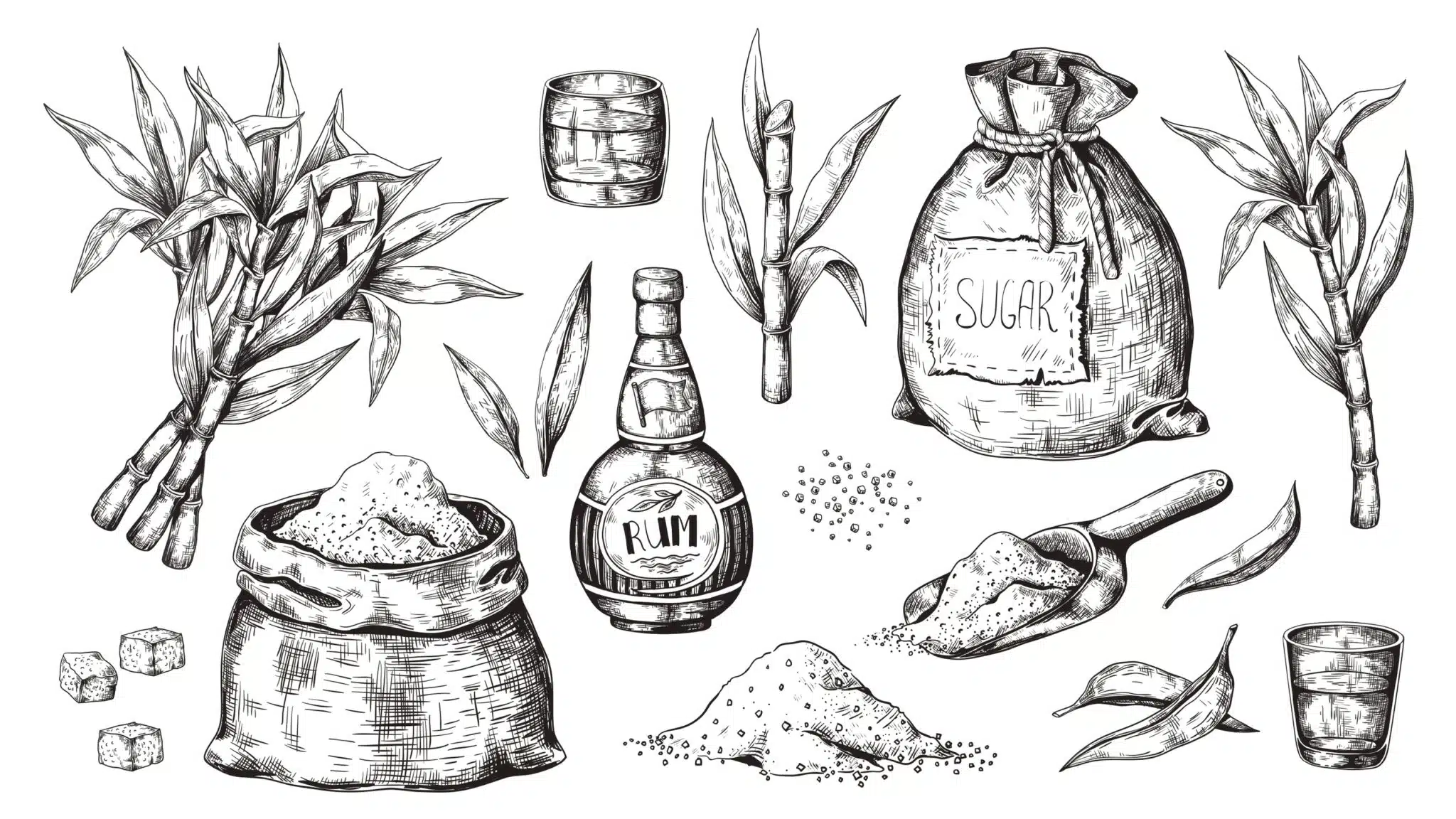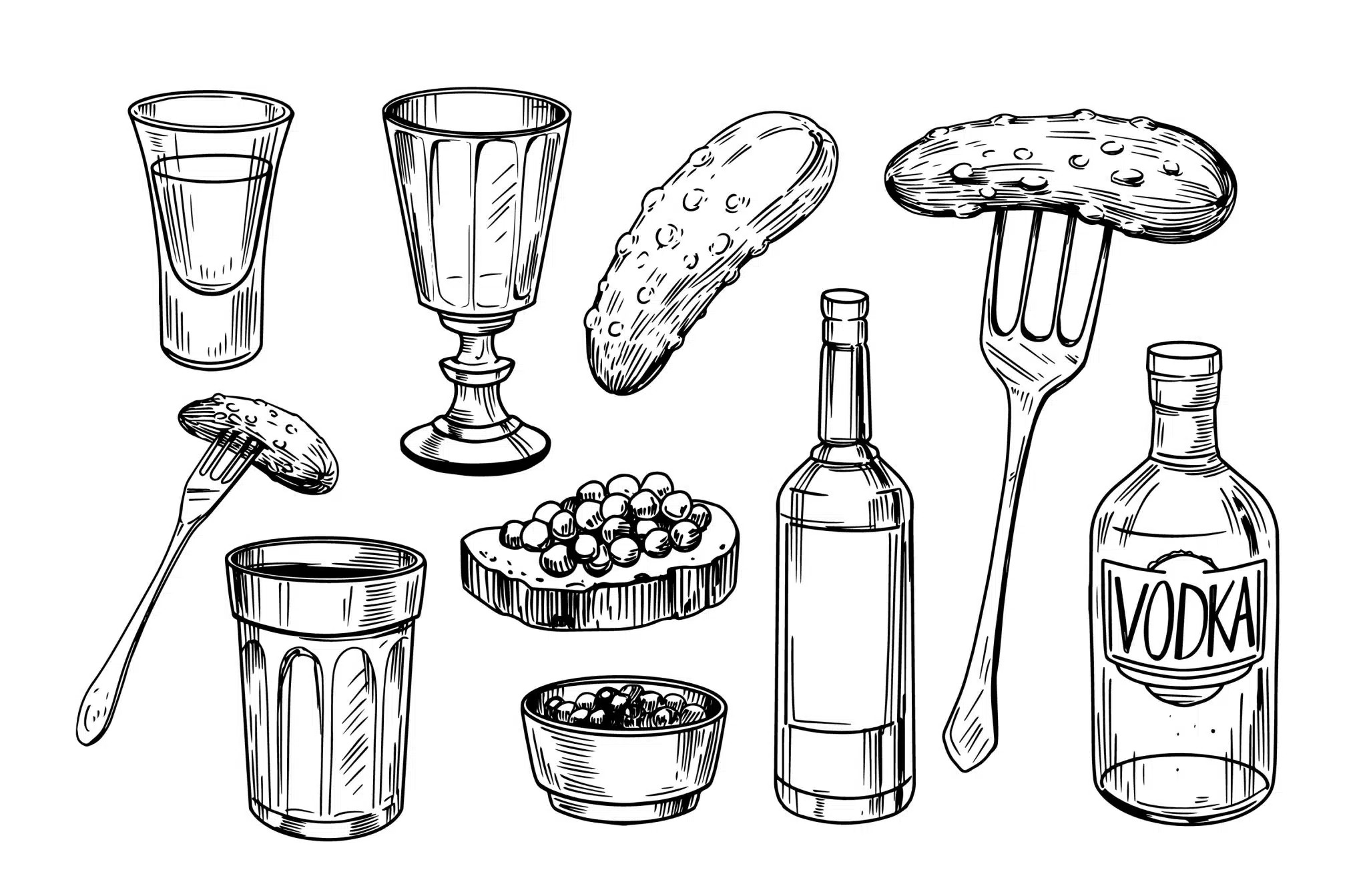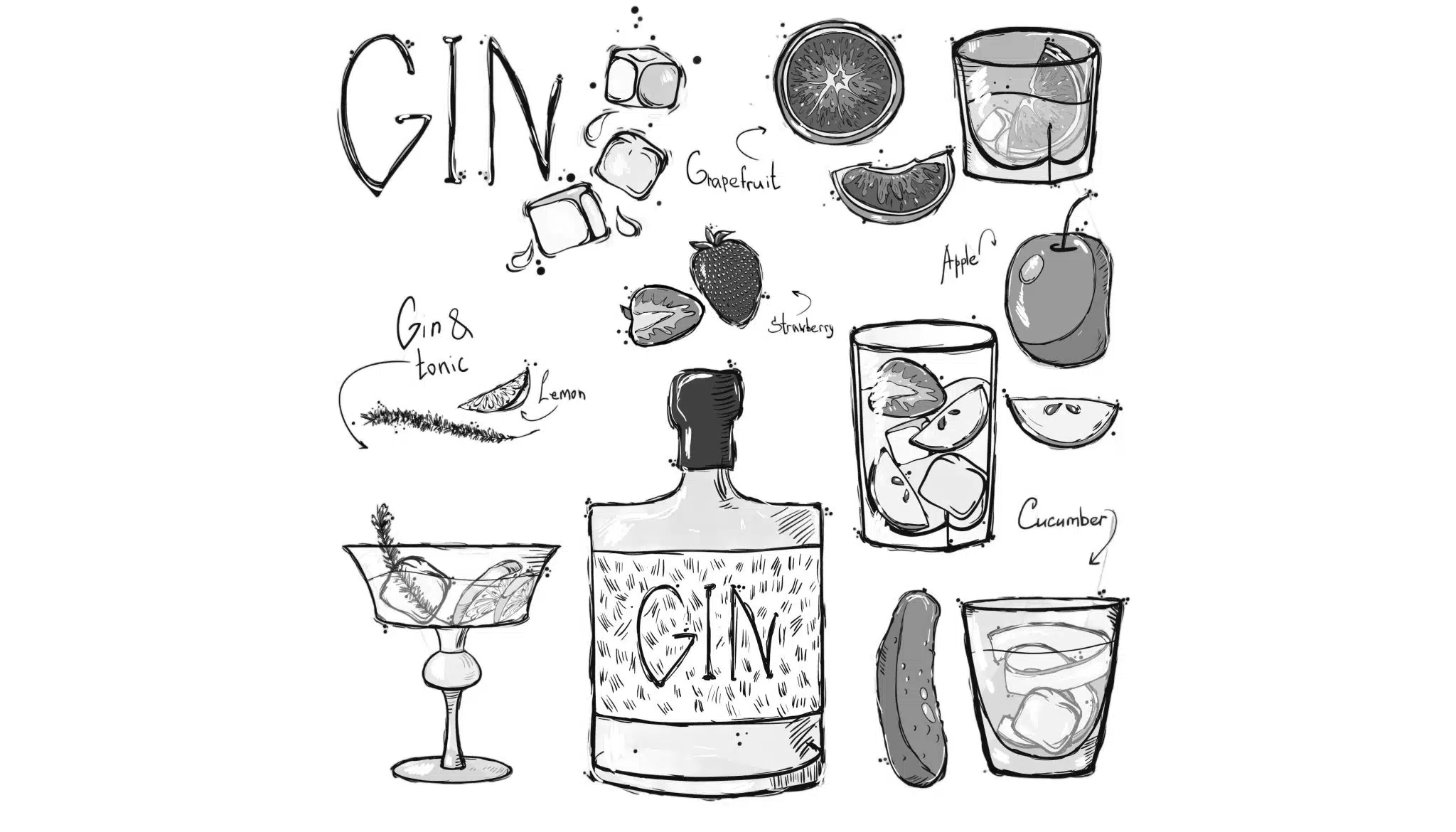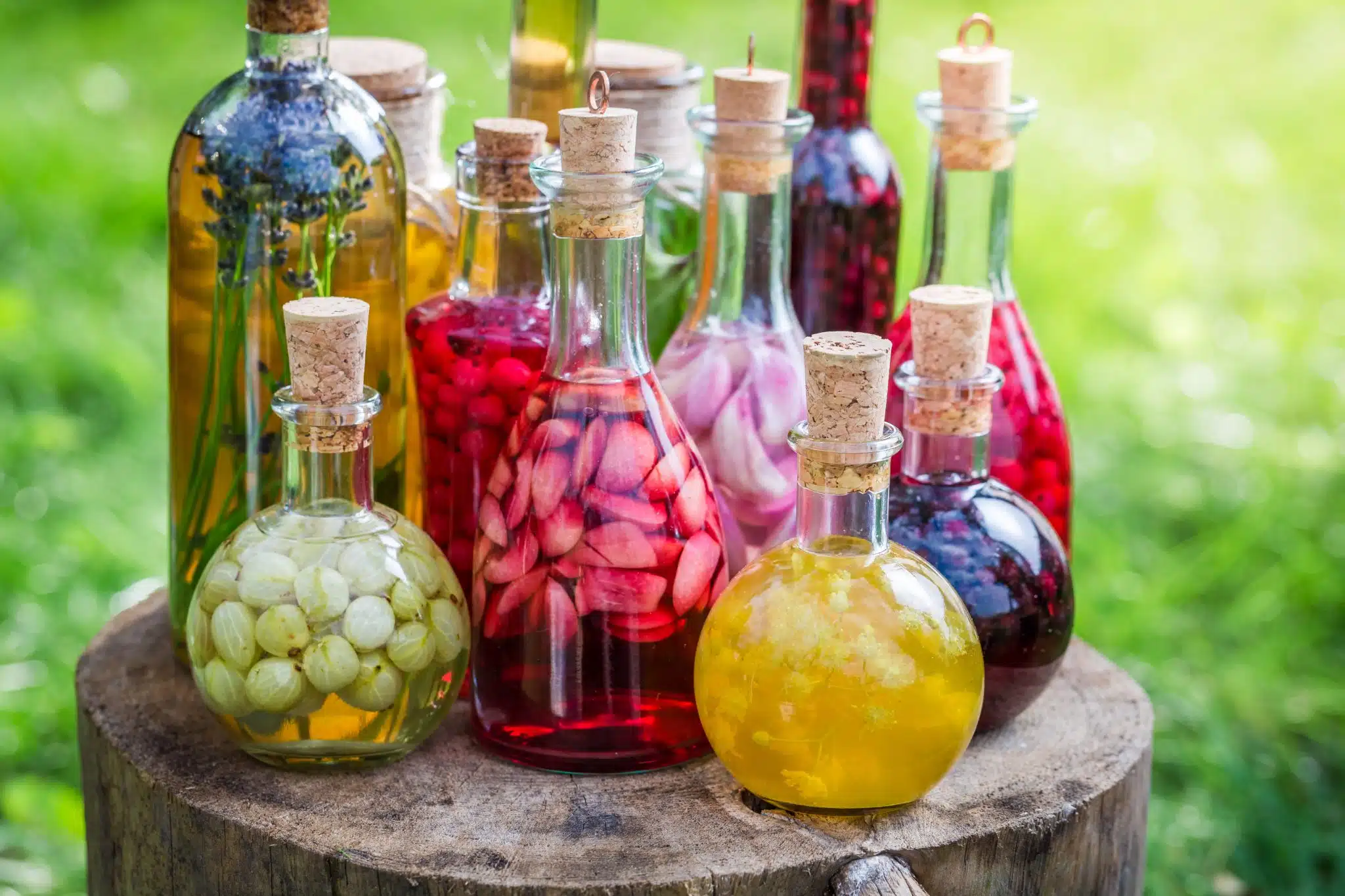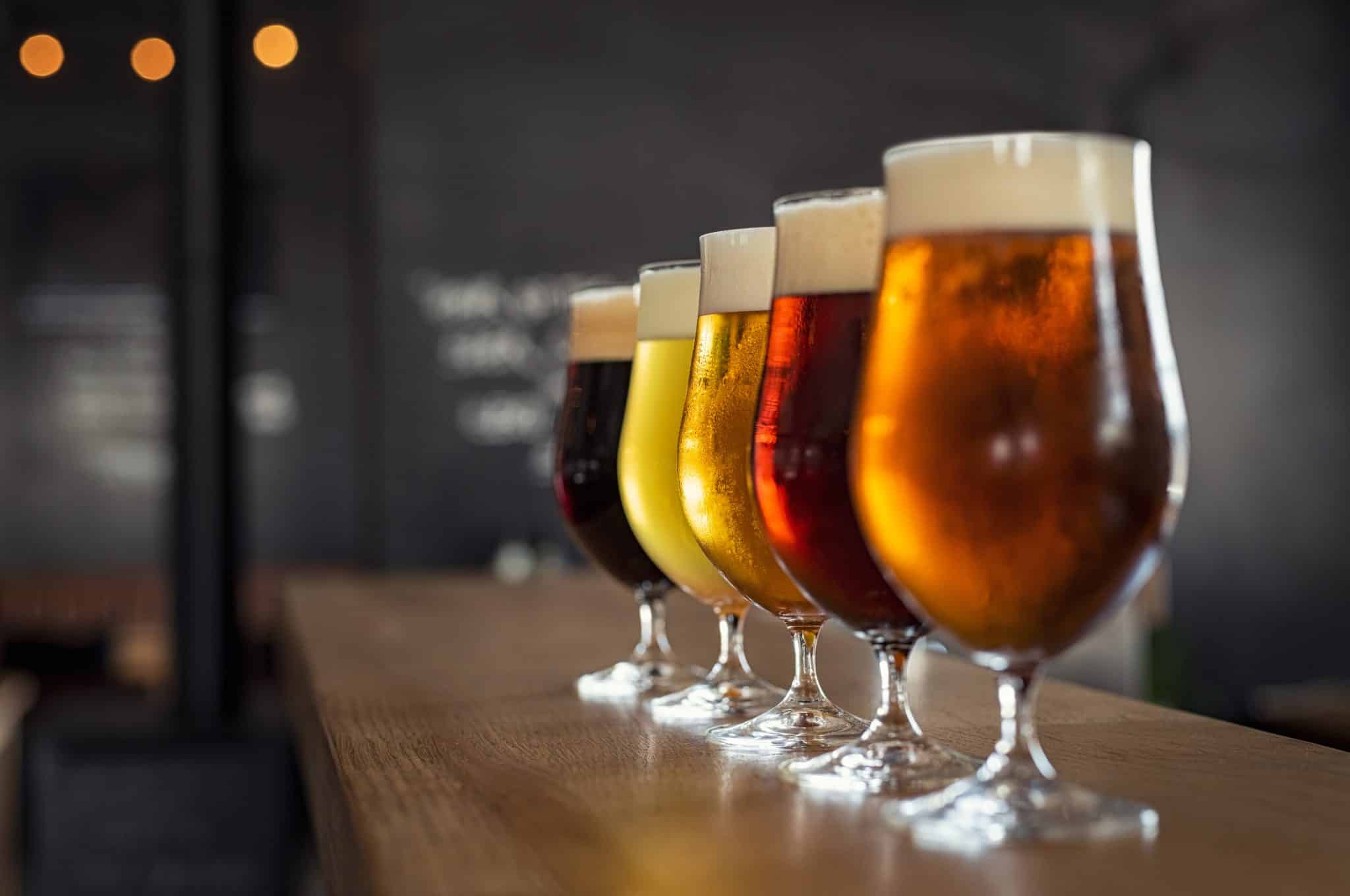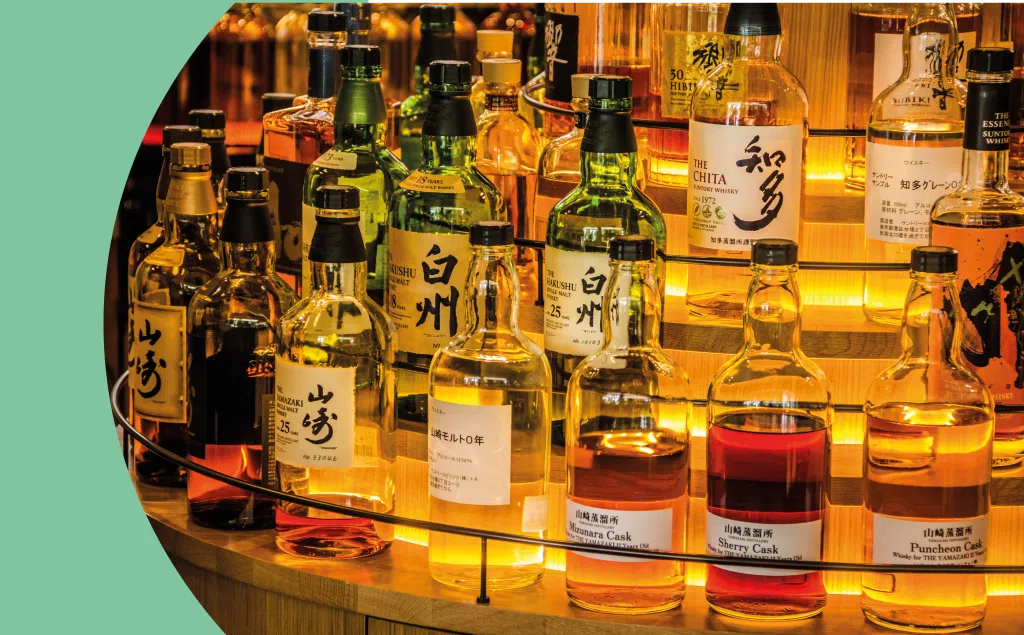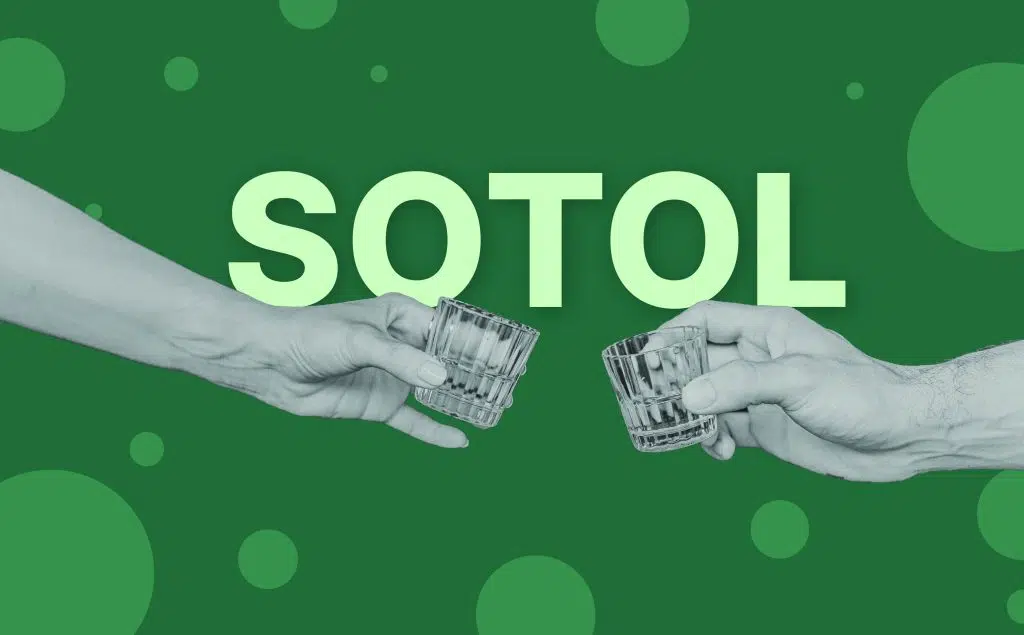On this page, you’ll learn about the different types of alcohol and liquor. Our experts give a complete overview of all the names and spirits that serve as a base for mixed drinks and cocktails.
Curious about the various types of alcohol and liquor names you come across in movies, restaurants, or stores? From drinks you can easily mix and make at home to fancy cocktails at parties: there’s a lot to learn! This article talks about cool spirits, where they come from (their origin), and list big brands behind them. We’ll also give some examples of popular drinks and how to mix them. So, whether you’re curious about the names on the bottles or just looking to impress your friends with a homemade cocktail, we’ve got you covered! Let’s get started!
Check also: List of Alcoholic Drinks and Beverages
Types of Alcohol
Alcohol, in the context of beverages, can be categorized into two types: fermented and distilled.
Fermented alcohols are produced through natural fermentation, where yeasts convert sugars into alcohol and carbon dioxide. This category includes beverages like beer, wine, and mead.
Distilled alcohols, also known as spirits or liquors, are created by distilling fermented beverages to increase their alcohol content. This category included various beverages, from whiskey and vodka to rum, tequila, and gin.
We explain these types further in separate sections below with information about the origin, ABV, brands, and cocktail examples.
Types of Liquor & Names (Distilled Spirits)
There are 7 categories of distilled spirits: Tequila, Whiskey, Rum, Brandy, Vodka, Gin and Liqueur. Some of them have 40% ABV (80 proof) or more, making them hard liquors. The 6 types of hard liquor are Tequila, Vodka, Brandy, Gin, Whiskey and Rum. Unlike beer or wine, which are fermented, hard liquors undergo a distillation process where the alcohol is concentrated. This process, along with the higher alcohol content, distinguishes them from other types of alcoholic beverages.
We’ve made an in-depth overview of all the different classifications:
Tequila
Tequila is a distilled alcoholic beverage from Mexico, made primarily from the blue agave plant. It’s known for its unique flavor and has a rich history. Mezcal is the category to which tequila belongs. Unlike Tequila, Mezcal can be produced from over 30 different agave species, giving it a broader flavor profile often described as smoky.
- Different Types or Subcategories of Tequila
- Blanco (Silver or White): Fresh and clear, aged very little or not at all.
- Reposado (Rested): Aged between two months and a year, giving it a light golden hue.
- Añejo (Aged): Between one and three years. It has a darker color and richer flavor.
- Extra Añejo (Ultra-Aged): Aged for over three years. It’s the most refined of the bunch.
- ABV: Typically between 35% to 55%, which tells you how strong it is.
- Taste Profile: Has a unique taste of agave, with some versions having hints of citrus, pepper, and herbs. The longer it’s aged, the more flavors like vanilla and oak come through.
- Popular Brands: Jose Cuervo, Patrón, Don Julio, and Herradura are big names you might recognize.
- Popular Cocktails: Margarita, Tequila Sunrise, and Paloma are famous drinks made with tequila.
- Historical Background/Origin: Tequila has deep roots in Mexico, dating back to the time of the Aztecs.
- Production Method: It’s made by fermenting and then distilling the sugary core of the blue agave plant.
Whiskey
Whiskey is a distilled alcoholic beverage made from fermented grain mash, aged in wooden casks. It’s produced in various regions worldwide, each with distinct characteristics. Bourbon, Scotch, and Rye are all subcategories of whiskey, each with unique production methods and flavor profiles.
- Different Types or Subcategories of Whiskey:
- Scotch: Made in Scotland, typically from malted barley, and aged for at least three years.
- Bourbon: An American style of whiskey made primarily from corn and aged in new charred oak barrels.
- Rye: Made primarily from rye grain, offering a spicier flavor profile.
- Irish Whiskey: Made in Ireland, typically triple-distilled and can be peated or unpeated.
- ABV: Typically ranges from 40% to 50%, but cask strength versions can be higher.
- Taste Profile: Whiskey flavors can range from sweet and fruity to smoky and peaty, depending on the grains used and the aging process.
- Popular Brands: Jameson, Jack Daniel’s, Johnnie Walker, and Glenfiddich are renowned names in the whiskey world.
- Popular Cocktails: Whiskey Sour, Old Fashioned, and Manhattan are classic whiskey cocktails that highlight whiskey’s versatility. Explore our array of whiskey drinks, with each type standing out for its special flavor and style:
- Bourbon cocktails
- Scotch cocktails
- Rye whiskey cocktails
- Japanese whiskey cocktails
- Historical Background/Origin: Whiskey has ancient roots, with records of distillation dating back to ancient Mesopotamia. Its name comes from the Gaelic word “uisce”, meaning “water”.
- Production Method: Whiskey is made by fermenting a grain mash, distilling it, and then aging the liquid in wooden barrels, which gives it its distinct color and flavor.
Rum
Rum is a distilled alcoholic beverage made primarily from sugarcane juice or molasses. It’s originally from the Caribbean but is now produced globally. Rum can vary in flavor, color, and strength depending on its origin and aging process.
- Different Types or Subcategories of Rum:
- White Rum: Light and clear, often used in cocktails due to its mild flavor.
- Dark Rum: Aged longer, has a deeper color and richer flavor, often with caramel or molasses notes.
- Gold Rum: A middle ground between white and dark, with a balanced flavor.
- Spiced Rum: Infused with spices like cinnamon, clove, and vanilla for added flavor.
- Agricole Rum: Made from fresh sugarcane juice rather than molasses, it tastes grassier.
- ABV: Typically ranges from 35% to 50%, though some overproof rums can be stronger.
- Taste Profile: Rum flavors can range from sweet and fruity to rich and smoky, depending on the ingredients and aging process.
- Popular Brands: Bacardi, Captain Morgan, Mount Gay, and Appleton Estate are well-known names in the rum world.
- Popular Cocktails: Mojito, Piña Colada, and Dark’ n’ Stormy are classic rum cocktails that showcase rum’s versatility. Check out our Rum drinks range, where every category has its own unique taste and character:
- Historical Background/Origin: Rum’s history is closely linked with the Caribbean, colonial trade, and naval traditions. It played a significant role in the colonial-era “Triangle Trade” between Europe, Africa, and the Americas.
- Production Method: Rum is produced by fermenting sugarcane juice or molasses, then distilling and aging the liquid in barrels, which can influence its flavor and color.
Brandy
Brandy is a distilled alcoholic beverage made from fruit juice, most commonly grapes. It’s known for its warm, fruity flavors and is often enjoyed as an after-dinner digestif. The type of fruit and aging process can significantly influence brandy’s character and taste.
- Different Types or Subcategories of Brandy:
- Cognac: A prestigious type of brandy from the Cognac region in France, made from specific grape varieties.
- Armagnac: Another French brandy from the Gascony region, distilled using different methods than Cognac.
- Pisco: A South American grape brandy popular in Chile and Peru.
- Fruit Brandy: Made from fruits other than grapes, like apples (Calvados) or cherries (Kirsch).
- Grappa: An Italian brandy from wine production’s pomace (residue).
- ABV: Typically ranges between 35% to 60%.
- Taste Profile: Brandy flavors can be rich and fruity, with notes of oak, vanilla, and caramel, especially if aged in wooden barrels.
- Popular Brands: Hennessy, Courvoisier, Rémy Martin, and Torres are some recognized names in the brandy world.
- Popular Cocktails: Sidecar, Brandy Alexander, and Pisco Sour are classic brandy cocktails highlighting the brandy’s smoothness.
- Historical Background/Origin: Brandy’s roots go back to ancient winemaking regions, where it was discovered that wine could be preserved through distillation. The name “brandy” comes from the Dutch word “brandewijn,” meaning “burnt wine.”
- Production Method: Brandy is produced by fermenting fruit juice, then distilling and often aging the liquid in barrels, which imparts additional flavors and a golden hue.
Vodka
Vodka is a distilled alcoholic beverage known for its clarity and purity, often made from fermented grains or potatoes. It originates from Eastern Europe, specifically Russia and Poland, and is prized for its neutral flavor, making it a versatile cocktail mixer.
- Different Types or Subcategories of Vodka:
- Standard Vodka: Typically neutral in flavor and smooth.
- Flavored Vodka: Infused with flavors ranging from fruits to spices or unique profiles like caramel or chocolate.
- Premium Vodka: Often distilled multiple times or using specific methods to achieve higher purity and smoothness.
- ABV: Typically around 40%, though some can be slightly lower or higher.
- Taste Profile: Vodka is characterized by its neutral flavor, with some brands offering a slight hint of the ingredients from which they’re distilled.
- Popular Brands: Smirnoff, Absolut, Grey Goose, and Belvedere are well-known names in the vodka market.
- Popular Cocktails: Moscow Mule, Cosmopolitan, and Bloody Mary are classic cocktails featuring vodka prominently.
- Historical Background/Origin: Vodka’s history is deeply rooted in the Slavic regions of Russia and Poland, where it was traditionally consumed neat and chilled.
- Production Method: Vodka is produced by fermenting grains or potatoes and then distilling the liquid multiple times to achieve clarity and purity. Some brands also use charcoal filtering to refine the spirit further.
Gin
Gin is a distilled alcoholic beverage known for its botanical flavors, with juniper berries being the dominant note. It originates from the Netherlands and England. Nowadays, craft distilleries experiment with many botanicals to create unique flavor profiles.
- Different Types or Subcategories of Gin:
- London Dry: A classic style, not necessarily from London, with a strong juniper flavor.
- Old Tom: Slightly sweeter than London Dry, often considered a bridge between London Dry and Dutch Genever.
- Genever: The Dutch precursor to modern gin, maltier and less botanical.
- Plymouth: A style specific to Plymouth, England, with a more earthy and softer juniper note.
- New Western or Contemporary: Gins that emphasize botanicals other than juniper.
- ABV: Typically ranges between 37.5% to 50%.
- Taste Profile: While juniper is the primary flavor, gins can also have notes of citrus, spice, floral, and other botanicals, depending on the brand and style.
- Popular Brands: Beefeater, Tanqueray, Hendrick’s, and Bombay Sapphire are iconic names in the gin world.
- Popular Gin Cocktails: Gin and Tonic, Gin Martini, Negroni, and Tom Collins showcase gin’s versatility in mixology.
- Historical Background/Origin: Gin’s origins trace back to the Netherlands, where it was produced as a medicinal liquor. It gained immense popularity in England, especially during the 18th-century Gin Craze.
- Production Method: Gin is made by distilling grain and then redistilling it with botanicals to extract the flavors. The dominant botanical, by law, is the juniper berry.
More distilled liquor names:
We listed below even more distilled liquors along with their signature cocktails:
- Absinthe: Known for its vivid green color and strong flavor. Cocktail: Absinthe Drip – Absinthe with cold water dripped over a sugar cube.
- Akvavit (or Aquavit): Distilled from grain or potatoes and flavored with caraway and dill. Cocktail: Nordic Snapper – Akvavit, tomato juice, lemon juice, Worcestershire sauce, and spices.
- Cachaça: A Brazilian spirit with a distinct flavor profile. Cocktail: Caipirinha – Cachaça, lime, and sugar. More about Cachaça Cocktails.
- Grappa: An Italian spirit from grape pomace. Cocktail: Grappa Sour – Grappa, lemon juice, simple syrup, and a dash of bitters.
- Ouzo: A Greek liquor with a strong anise flavor. Cocktail: Ouzo Lemonade – Ouzo, lemon juice, and soda water.
- Schnapps: Distilled from fruit or grain, popular in Europe. Cocktail: Apple Schnapps Spritzer – Apple schnapps, soda water, and a splash of lemon.
- Soju: A clear Korean liquor. Cocktail: Soju Sunrise – Soju, orange juice, and a splash of grenadine.
- Sake: A Japanese “rice wine” with a delicate flavor. Cocktail: Sake Martini – Sake, vodka, and sometimes a hint of ginger.
- Mezcal: A smoky variant of tequila. Cocktail: Mezcal Margarita – Mezcal, lime juice, triple sec, and agave syrup.
- Pastis: An anise-flavored liquor from France. Cocktail: Mauresque – Pastis with almond syrup and water.
- Rakia (or Rakija): A Balkan fruit brandy. Cocktail: Rakia Sour – Rakia, lemon juice, simple syrup, and a cherry garnish.
- Slivovitz: A plum brandy from Slavic regions. Cocktail: Slivovitz Old Fashioned – Slivovitz, sugar, water, and bitters.
- Shōchū: A versatile Japanese liquor. Cocktail: Shōchū Highball – Shōchū, soda water, and a lemon twist.
Liqueur Names and Types
Liqueurs are sweetened distilled spirits infused with flavors from fruits, herbs, spices, or other botanicals. They often have a lower alcohol content (15% to 30% ABV) than spirits and are used in liqueurs cocktails or consumed neat.
Fruit Liqueurs
These drinks capture the taste of fresh fruits, from zesty oranges to sweet berries. They’re often sweet and can be enjoyed on their own or mixed in cocktails. Think of them as a way to add a fruity twist to your drink.
- Orange: Grand Marnier, Cointreau, Triple Sec, Curacao
- Berry: Chambord (Raspberry), Crème de Cassis (Blackcurrant), Crème de Mûre (Blackberry)
- Cherry: Cherry Heering, Luxardo Maraschino
- Lemon: Limoncello (brands like Pallini, Caravella)
- Other Fruits: Midori (Melon), Pama (Pomegranate), Crème de Banane (Marie Brizard)
Cream Liqueurs
Imagine blending alcohol with rich, creamy flavors like chocolate or vanilla. These drinks are smooth and often enjoyed over ice or in coffee. They’re like dessert in a glass!
- Dairy-based: Baileys Irish Cream, Amarula, Coole Swan
- Vegan or non-dairy: Almondaire (almond-based)
Herbal & Botanical Liqueurs
Made with plants and herbs, these drinks can have complex flavors. Some might taste like flowers, while others are more earthy. They’re a mix of nature’s best flavors with a kick.
- General herbal: Jägermeister, Chartreuse, Strega
- Elderflower: St. Germain
- Bitter herbs (Amari): Aperol, Campari
Nut Liqueurs
If you love the taste of nuts, these drinks are for you. They can taste like almonds, hazelnuts, or even walnuts. It’s like sipping on your favorite nutty treat.
- Almond: Amaretto (Disaronno, Lazzaroni)
- Hazelnut: Frangelico
- Walnut: Nocino (brands like Don Ciccio & Figli)
- Others: Pistachio (Dumante Verdenoce)
Coffee Liqueurs
For those who love a caffeine boost, these drinks blend the rich taste of coffee with alcohol. They’re great for adding a coffee flavor to cocktails or just sipping neat.
- Brands: Kahlúa, Tia Maria, Mr. Black
Anise-flavored Liqueurs
These have a unique taste that’s a bit like licorice. They’re strong and bold, often enjoyed in small amounts.
- General anise: Sambuca (Romana), Ouzo (Metaxa), Pastis (Ricard)
Chocolate Liqueurs
Who doesn’t love chocolate? These drinks are a blend of sweet chocolate flavors and alcohol. Perfect for those with a sweet tooth.
- Brands: Godiva, Crème de Cacao (Tempus Fugit, Marie Brizard), Mozart Chocolate Cream
Honey Liqueurs
Sweet and smooth, these drinks capture the taste of honey. They can be sipped on their own or used to sweeten other drinks. It’s like a touch of nature in your glass.
- Brands: Drambuie, Bärenjäger, Krupnik
Spice Liqueurs
These drinks are all about bold flavors like cinnamon or vanilla. They can add a spicy kick to cocktails or be enjoyed neat. They’re perfect for those who like a bit of heat.
- Cinnamon: Fireball, Goldschläger
- Vanilla: Licor 43
- Others: Galliano (vanilla-anise)
Floral Liqueurs
Imagine the scent of flowers turned into a drink. These have delicate flavors that can remind you of a blooming garden. They’re light and refreshing.
- Violet: Crème de Violette (Rothman & Winter, Giffard)
- Rose: Lanique
- Lavender: Rothman & Winter Orchard Apricot with Lavender
Whiskey-based Liqueurs
These drinks take the rich flavors of whiskey and add a twist. They might be sweetened or mixed with other flavors. They’re a different take on the classic whiskey taste.
- Brands: Southern Comfort, Glayva, Drambuie
Bitter Liqueurs (Amari)
These have a strong, often bitter taste. They’re made with a mix of herbs and plants. Some people love them after a meal to help with digestion.
- General Amari: Averna, Ramazzotti, Montenegro
- Fernet-style: Fernet-Branca
Miscellaneous Liqueurs
Advocaat (Warninks), Schnapps (DeKuyper, Hiram Walker)
Wine and Beer (Fermented Alcohol)
Wine
Red Wine
Red wines are made from dark-colored grape varieties. The color can range from intense violet to brick red, depending on age and type. They get their color from the grape skins, which are included in the fermentation process.
- Light-bodied: Beaujolais (e.g., Georges Duboeuf, Louis Jadot, Joseph Drouhin)
- Medium-bodied: Chianti (e.g., Ruffino, Antinori, Banfi)
- Full-bodied: Cabernet Sauvignon (e.g., Robert Mondavi, Silver Oak, Caymus)
White Wine
White wines are made from green, yellowish, or red grapes with skins removed before fermentation. They’re known for their light, crisp flavors, ranging from sweet to dry. Common flavors include apple, pear, and citrus.
- Light-bodied: Pinot Grigio (e.g., Santa Margherita, Kris, Jermann)
- Medium-bodied: Chardonnay (e.g., Kendall-Jackson, Chateau Ste. Michelle, Sonoma-Cutrer)
- Full-bodied: Viognier (e.g., Yalumba, Condrieu, Tablas Creek)
Rosé Wine
They are often pink in color and are made from red grape varieties. The skins of the grapes are in contact with the juice for a short time, giving it a pink hue. They’re usually light and refreshing, perfect for warm days.
- Still Rosé: Whispering Angel, Miraval, AIX
- Sparkling Rosé: Billecart-Salmon, Moët & Chandon, Laurent-Perrier
- Sweet Rosé: Beringer White Zinfandel, Sutter Home White Zinfandel, Gallo Family Vineyards White Zinfandel
Sparkling Wine
These wines have significant levels of carbon dioxide, making them fizzy. The carbonation can result from natural fermentation or by adding carbon dioxide. They range from sweet to dry and are often associated with celebrations.
- Champagne: Dom Pérignon, Veuve Clicquot, Krug
- Prosecco: La Marca, Mionetto, Zonin
- Cava: Freixenet, Codorníu, Segura Viudas
- Sekt: Henkell Trocken, Rotkäppchen, Söhnlein Brillant
- Crémant: Lucien Albrecht Crémant d’Alsace, Bailly Lapierre Crémant de Bourgogne, Domaine J. Laurens Crémant de Limoux
Dessert Wine
Dessert wines are sweet and typically served with dessert or as dessert themselves. They’re made using several methods, like late-harvesting or using botrytized grapes. They’re richer and sweeter than other wines.
- Late Harvest: Inniskillin Riesling Late Harvest, Robert Mondavi Moscato d’Oro, Chateau Ste. Michelle Late Harvest Riesling
- Ice Wine: Jackson-Triggs Vidal Icewine, Inniskillin Gold Vidal Icewine, Peller Estates Cabernet Franc Icewine
- Noble Rot: Château d’Yquem, Royal Tokaji, Château Climens
Orange Wine
These white wines are made like red wines, with grape skins left in contact with the juice for an extended period. This gives them a deep orange hue and a robust flavor profile with some tannin. The top brands are Gravner Ribolla, Radikon, and Pheasant’s Tears.
Natural Wine
These are made with minimal intervention, meaning fewer additives and less technology in the winemaking process. They’re often unfiltered, leading to a cloudy appearance, and can have unique, sometimes funky, flavors.
Top brands are Domaine de la Tournelle, La Stoppa, Clos du Tue-Boeuf
Biodynamic Wine
These come from vineyards that follow biodynamic farming practices, which consider the vineyard a whole ecosystem. This method also follows a specific calendar and uses preparations for fermented manure, minerals, and herbs.
Top brands are Domaine Zind-Humbrecht, Nikolaihof, Querciabella
Organic Wine
These are made from grapes without synthetic fertilizers, pesticides, or herbicides. The winemaking process also avoids or limits the use of added sulfites. They’re seen as a more natural representation of their terroir.
Top brands are Bonterra, Frey Vineyards, Emiliana Organic Vineyards.
Fortified Wine Types and Names
Port
Port comes from Portugal and is a sweet wine, often enjoyed after meals. It’s made by adding strong alcohol during the process. There are different kinds, some tasting fruity and others having a nutty flavor.
- Vintage Port: Taylor’s, Sandeman, Quinta do Noval
- Tawny Port: Graham’s, Dow’s, Cockburn’s
- Ruby Port: Fonseca, Croft, Ramos Pinto
- White Port: Dow’s, Ferreira, Quinta do Noval
- Late Bottled Vintage (LBV): Warre’s, Smith Woodhouse, Quinta de la Rosa
Sherry
Sherry is from the Jerez region of Spain and can taste from very dry to super sweet. It’s aged in a special way where older wines get mixed with newer ones. Different types can taste like almonds or sweet raisins.
- Fino: Tio Pepe, Gonzalez Byass, Lustau
- Manzanilla: La Gitana, Delgado Zuleta, Barbadillo
- Amontillado: Lustau, Hidalgo, SandemanOloroso: Gonzalez Byass, Emilio Lustau, Alvear
- Palo Cortado: Valdespino, Lustau, Hidalgo
- Pedro Ximénez: Alvear, Romate, Osborne
- Cream Sherry: Harvey’s Bristol Cream, Croft Original, Lustau East India Solera
Madeira
Madeira is named after an island in Portugal. It’s known for being aged with heat, which gives it a unique caramel taste. Some are dry, while others are sweet.
- Sercial: Barbeito, Justino’s, Broadbent
- Verdelho: Blandy’s, Cossart Gordon, Justino’s
- Bual (or Boal): Henriques & Henriques, Blandy’s, Broadbent
- Malmsey (or Malvasia): Cossart Gordon, Blandy’s, Justino’s
Marsala
Marsala comes from Sicily, Italy. It has a rich, sweet taste and is often used in cooking. But you can also drink the outstanding ones by themselves.
- Oro (gold): Florio, Pellegrino, Curatolo Arini
- Ambra (amber): Pellegrino, Florio, Marco De Bartoli
- Rubino (ruby): Curatolo Arini, Florio, Pellegrino
- Fine: Cantine Pellegrino, Florio, Donnafugata
- Superiore: Donnafugata, Florio, Pellegrino
- Superiore Riserva: Marco De Bartoli, Florio, Pellegrino
- Vergine: Florio, Pellegrino, Curatolo Arini
- Vergine Stravecchio: Duca di Salaparuta, Florio, Pellegrino
Vermouth
Vermouth is wine mixed with herbs and spices. There are two main kinds: one is sweet and often red, and the other is dry and usually white. It’s used a lot in making cocktails. Check out our page about Vermouth Cocktails.
- Dry Vermouth (or White Vermouth): Noilly Prat, Dolin, Martini & Rossi
- Sweet Vermouth (or Red Vermouth): Martini & Rossi, Cinzano, Punt e Mes
- Rosé Vermouth: Lillet Rosé, Dolin Rosé, Mancino Rosé
Muscat
Muscat is super fruity and comes from a particular type of grape. They’re sweet and have a strong smell of flowers and fruits. Some famous ones come from France and Australia.
- Muscat de Beaumes-de-Venise: Domaine de Durban, Château Saint-Roch, Domaine des Bernardins
Vins Doux Naturels
These are sweet wines from the South of France. They’re made by adding strong alcohol to keep them sweet. They can be red, white, or even pink.
- Red: Maury (e.g., Mas Amiel, Domaine de la Coume du Roy, Domaine Pouderoux)
- White: Muscat de Rivesaltes (e.g., Domaine Cazes, Domaine Gardiés, Domaine Lafage)
- Rosé: Banyuls Rosé (e.g., Domaine La Tour Vieille, Domaine de la Rectorie, Domaine Madeloc)
Beer
Beer is among the world’s oldest and most widely consumed alcoholic types of beverages. It’s made primarily from water, malted barley, hops, and yeast. The fermentation process, where yeast converts sugars from the malted barley into alcohol and carbon dioxide, gives beer its alcohol content and carbonation. The two main categories of beer, based on the type of yeast and fermentation method used, are Ale and Lager.
Ale
Ales are brewed with top-fermenting yeast called Saccharomyces cerevisiae. This yeast ferments at warmer temperatures, usually between 60-72°F (15-22°C). Ales encompass a wide variety of beer styles, including IPAs, stouts, porters, and Belgian ales, to name a few. They often have a more robust flavor and can be fruity or spicy due to the yeast’s characteristics.
Lager
Lagers are made with bottom-fermenting yeast known as Saccharomyces pastorianus. This yeast ferments at cooler temperatures, typically between 44-55°F (7-13°C). Lagers include styles like pilsners, bocks, and helles. They tend to have a cleaner, crisper taste with a smooth finish, often showcasing the malt or hops more than the yeast.
Other Fermented Beverages
There are several other fermented alcoholic beverages from various parts of the world. Here are some of them:
- Cider: Made from the fermented juice of apples.
- Perry: Similar to cider but made from fermented pear juice.
- Mead: Made from honey and water, sometimes with added fruits, spices, or grains.
- Sake: A Japanese beverage made from fermented rice.
- Pulque: A traditional Mexican drink made from the sap of the maguey plant.
- Chicha: A traditional South American drink from maize or yucca.
- Palm Wine: Made from the sap of various species of palm trees.
- Kumis (or Airag): Made from mare’s milk, popular in Central Asia.
- Toddy: A drink made from the fermented sap of palm trees, especially in India and Southeast Asia.
- Huangjiu: A traditional Chinese alcoholic beverage made from rice, millet, or wheat.
- Makgeolli: A Korean traditional alcoholic beverage made from rice.
- Rakı: A popular drink in Turkey made from twice-distilled grapes and aniseed.
- Arrack: Distilled from sugarcane, grain, or fruit, popular in South Asia and Southeast Asia.
- Tepache: A fermented pineapple beverage from Mexico, though its alcohol content can be pretty low.
- Slivovitz: A fruit brandy made from distilled plum juice, popular in the Balkans.





